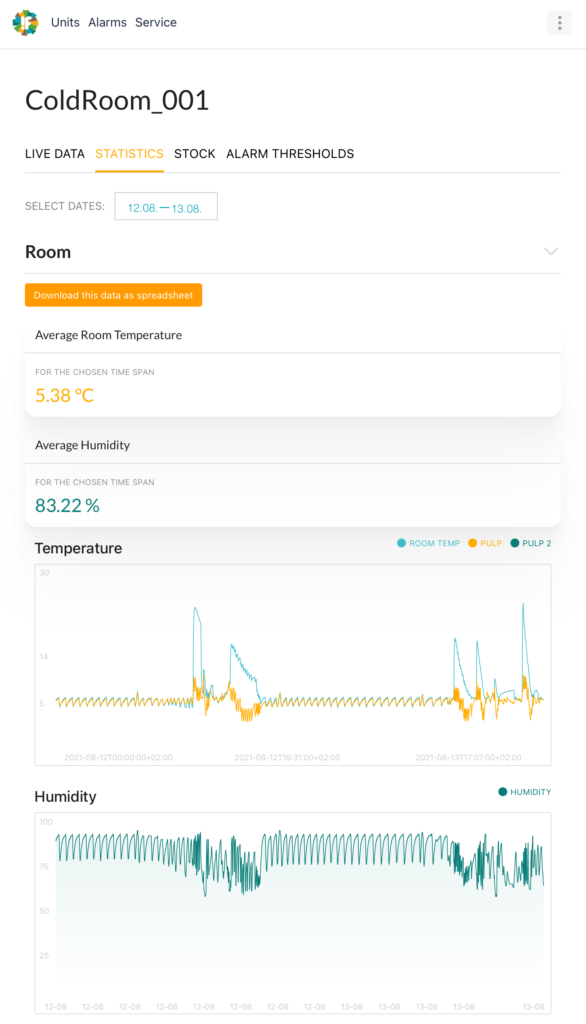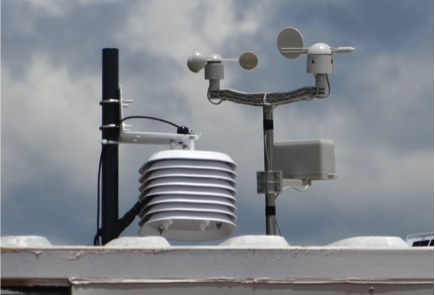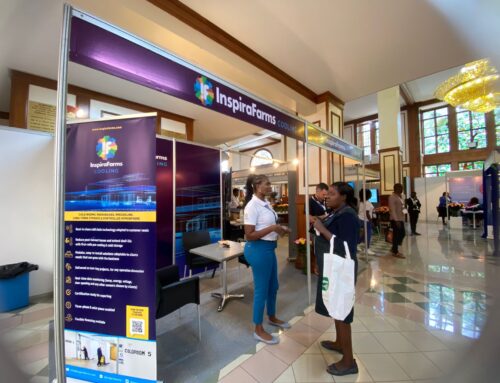How the bundling and interconnection of devices is allowing farms and agribusinesses in Africa to leap into the future
Fruits and vegetables cold chain logistics require special monitoring and supervision around different key aspects, such as appropriate low-temperature environment and related humidity, during all post-harvest stages (pre-cooling processing, cold storage, transportation, etc.). Effective pre-cooling, temperature management and dehydration control are among the most important strategies to extend shelf life and retain the quality of fruits and vegetables. Traditionally this level of control has required high frequency, high skill human resources’ monitoring and manual logging to ensure the best quality, accuracy, coordination, and timely delivery.
Remote monitoring – the use of sensors and Internet of Things (IoT) systems for supervising and controlling systems and facilities remotely is bringing a more granular and consistent measurement of different indicators of fresh produce cold chain. The real-time capturing of data on the conditions of fruits and vegetables, on cooling and storage conditions, on energy consumption and on machinery performance is allowing customers to be in control of dehydration, shelf-life and route to market, increasing revenues while monitoring performance and energy consumption ensuring OPEX is kept under control. Additional features such as monitoring of CO2 levels, alarms and CCTV increase the ability to manage safety and security.
The data collected and insights produced are of great importance to farmers and agribusinesses, increasing their ability to manage operations and maximize their revenues, while allowing logistics companies and off-takers to assess quality and volumes to make logistical decisions remotely. When streamlined through a supply chain and integrated with reefer loggers and ERPs, InspiraFarms IoT system also provides a tool to support the negotiation on rejections, pricing and last resource along the chain.
We discuss at least five benefits of monitoring systems for your fresh produce cold chain that will improve the quality and market of your produce concurrently, saving on costs and helping the environment.
1.Quality & Safety Assurance
For your fresh produce to reach profitable markets, one requires increased sensitivity to the quality, nutritional value, and safety of agricultural products. Quality & safety can be kept by controlling all post-harvest treatment, such as pre-cooling time or temperature and humidity management.
Every crop has a specific post-harvest protocol to be followed, based on the commercial target. The higher are temperatures, the higher is respiration rate and therefore, reducing shelf-life. Excess cold or heat can bring in a meaningful amount of water loss, reducing the value of the harvested volumes. A badly managed cold chain can cause injuries, post-harvest disorders, and molding, reducing the value, increasing rejections and affecting the whole batch.

The supervision of quality compliance protocols & cooling performance (temperature and humidity levels among others) is facilitated through real-time data, which allows minimization of temperature and humidity fluctuation, that can have a major impact on the cold room internal atmosphere quality and affect shelf life and quality of the fruit and vegetables.
The capturing and logging of facilities’ internal and external environmental conditions are then converted into information that enables our customers to take throughput and quality management decisions.
If this wasn’t already a step into the future, the IoT system enables one to learn on aggregated customers’ data and to develop crop-specific pre-cooling and storage recipes that allow automated cycle control, reducing the operators’-based challenges of traditional cooling systems. In the case of out-grower schemes, one can set pre-established cooling programs, where farmers are only required to push a ‘stop/start’ button, under remote supervision of the aggregator/exporter.
Data through detailed quality reports can be shared and tracked by buyers, exporters, importers, retailers etc. demonstrating the compliance of protocols, potentially reducing claims and rejections.
2. Loss Prevention
Remote monitoring provides real-time data and sends alerts the minute something goes wrong. For instance, temperature sensors can send an alert to the appropriate parties when temperatures are not right or not following pre-established protocols. Managers can then send out a technician to transfer the load or help counteract the problem. In this way, proactive alerts allow agribusinesses to remain agile and respond quickly across a cold chain.
This minimizes waste of fresh produce by preventing product loss by managing cooling temperatures and controlling crop quality and with an instant share of detailed quality reports with buyers that potentially reduces claims and rejections. It also enables early diagnosis of issues, reducing considerably potential down-time.
3. Operational Savings & Efficient Planning
All these operational controls and supervisions are traditionally done manually, requiring more than 3 man/hours per room per day. Through remote monitoring, this manpower can be refocused on other tasks, and labour productivity can be increased, while eliminating operators’ biases and mistakes or loss of paper- based logs.
Remote monitoring can also support regular equipment maintenance. The remote and constant supervision of critical machine settings allows a maximum performance of cooling technology. For instance, it would be difficult to know of a problem occurring with the machines if they are down. With remote sensing, InspiraFarms can detect most technical issues before the problem occurs and provide remote interventions, with shortened intervention times, increasing uptime.
This therefore will help minimize down-time required to fix a minor problem that could eventually turn big and later increase the operational costs or affect the quality of produce.
A complete digital monitoring of pre-cooling and cold chain operations can contribute to more than 10% of total operational cost savings. The collection of data since post-harvest enables farmers and agribusinesses to see ahead and make decisions in order to eliminate any emerging issues and in return, reducing losses.
In this regard, remote monitoring systems for on-farm cooling allows for a much simpler way of analyzing past data to plan for the future of cold chain’s agribusiness. As data is collected over months or years, it is important to evaluate what has worked well or what has not in the past, in order to plan for better surroundings for growth and maintenance of crops quality.
4. Security
Storage of fruits and vegetables may bring about concerns of physical access such as theft or tampering of surround systems. Remote monitoring offers the options of securing your cold room with security passcodes, backup systems and alarms that enables one to track any access by unauthorized parties. However, security of cold rooms could mean more than physical access to the cold room. It could also mean protection of operational settings that could affect temperature settings for your crops. Remote monitoring will also help in tracking who goes in and out of the cold rooms and packhouses, controlling physical access to maintain a standard and effective atmosphere for your harvested produce.
5. Sustainable Food Chains
InspiraFarms approach to cold chain can support the efforts to achieve sustainable farming further ensuring that post-harvest losses are kept at a minimum, in the most efficient way. Monitoring systems are also used to regulate various aspects such as energy consumption and water usage that all lead to less loss of food and inefficient use of resources and costs by kg sold.
Final Insights
The use of monitoring systems is vital to control the pulp temperature of fruit and vegetables. Not achieving that target pulp temperature on every fruit on every pallet might generate massive commercial losses. InspiraFarms remote monitoring systems enable early risk detection and quick mitigation of those risks to ensure that revenues to agribusinesses are maximized in the most efficient, sustainable and effective way. The impact of off-protocol temperature is irreversible to your crops and to your cold chain and should be well taken care of. Investment in remote monitoring will help you increase cash from sales, manage your costs and achieve maximum energy efficiency.



